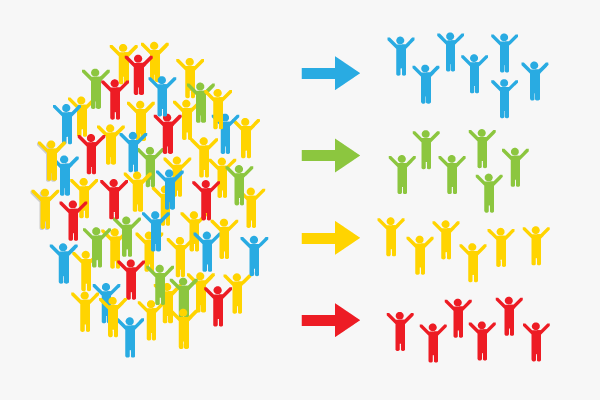Segmentation
Segmentation essentially involves something big being divided into smaller segments.
Segmentation occurs in many different areas. In biology, for example, earthworms are made up of several segments. In linguistics, words and sentences are divided into smaller units, and in the field of IT, the memory area can be divided into several segments.
In economics, market segmentation, i.e. the subdivision of customer or product types.
Segmentation criteria
Market segmentation
It is possible to divide potential visitors of a website into smaller groups according to their purchasing behavior, thus segmenting the overall market. The behavior within a group is homogeneous.
For example, it can be differentiated according to criteria for purchasing behavior:
- Demographically: age, gender, household size, etc.
- Sociographically: occupation, income, housing conditions, etc.
- Psychographically: attitudes, personality traits, lifestyle, as well as values, etc.
- Geographically: location and region, etc.
- Behavior-oriented: media usage, price orientation, etc.
Customer segmentation
Criteria for customer segmentation include for example sales to the customer and the duration of the customer relationship, both quantitative criteria.
Possible segmentation
As already indicated, there are a large number of possible criteria by which a segmentation can be effected. The segmentation of the target groups by age and lifestyle is frequently used.
Segmentation by age
The following segmentation with regard to age has been established:
- Post-war generation (born 1925 - 1945)
They witnessed the Great Depression of the 1930s and the Second World War, and took part in the post-war reconstruction. They value savings, cash, and dispense with loans. They are best addressed with print media and radio advertising.
- Baby boomers (1946 - 1964)
The baby boomer generation was born in the time of John F. Kennedy, Elvis, the Rolling Stones and the Beatles, and have witnessed the emergence of television, cassettes, and transistor radios. They are often brand loyal customers, who are generally best reached through classic mass media.
- Generation X (1965 - 1979)
Important events in their younger years were, for example, the fall of the Berlin Wall and the explosion of the Challenger. They like to inform themselves and can best be addressed through targeted, direct advertising.
- Generation Y (1980 - 1994)
They have already experienced the advent of the Internet, email, SMS, game consoles and DVDs. Their youth was marked by films such as Titanic and Reality TV, Britney Spears and Jennifer Lopez, as well as experiences such as September 11, 2001. They tend to be less faithful to brands and are influenced in their decisions mostly by friends and family. Viral marketing and electronic media are suitable means for marketing to this segment.
- Generation Z (1995 - present)
This latest generation is characterized by 3D movies in the cinema, smart TV, the Iran and Afghanistan conflicts, the tsunami in Asia in 2004 and WikiLeaks. They often buy impulsively and spontaneously and prefer online shopping. They can best be won over by a company with interactive campaigns.
Segmentation by lifestyle
Groups of customers can also be distinguished according to their lifestyle preferences, for example:
- LOHAS (lifestyles of health and sustainability)
LOHAS choose a health-conscious lifestyle. They are interested in topics such as health, sustainability, organic food, slow food, and take outdoor vacations. They often have an above-average income.
- LOVOS (lifestyles of voluntary simplicity)
These people make a conscious choice for a life of simplicity, in order to escape the over-consumption of modern times.
- DINK (double income no kids)
This acronym refers to married or unmarried couples who work full time and thus earn a double income, but do not have children. They have a high household income, are often upper middle class and are of particular interest to advertisers.
- Yuppies (young urban professionals)
"Yuppies" generally refers to city dwellers who are career-oriented and belong to the upper middle class. They hold management positions in large companies, have an optimistic attitude, and are successful. Thanks to their high income they can afford expensive apartments and enjoy an excessive lifestyle with a high level of consumption.
- Yollies (Young old leisure people)
These retirees are “young at heart” and enjoy their retirement. They are supported by handsome retirement benefits.
Objectives of segmentation
The market relevant for an enterprise is defined through market segmentation. The segmentation of customers based on common characteristics allows more targeted marketing. By differentiation, customers can be given a precise offer and their attention directed towards the products or services of particular interest to them. Thus, a more personalized marketing approach is possible since customer needs are evident.
Relevance to online marketing
It is possible to reach a variety of customer groups through the World Wide Web. Different user groups can be addressed using different social networks such as the younger target groups who specifically use the Internet, but it is also possible to specifically address an older audience with relevant pages. It is therefore important for a company to consider user segmentation before online ads get placed or a profile is created in a social network.

